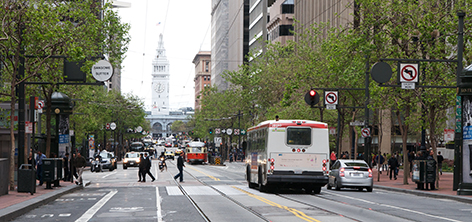
The San Francisco Municipal Transportation Agency is getting the rules of the road all wrong and the agency needs to fix its mistakes.
In recent years that agency — the SFMTA — has been creating more and more transit-only lanes. Some of these lanes are painted red, but not all of them are. The agency has consistently, in email after email and presentation after presentation, marketed these lanes to the public as a means to speed up Muni.

However, it appears that on March 28, 2014, two months after the seven unelected members of the SFMTA Board of Directors passed legislation to create the controversial Commuter Shuttle Pilot Program and Policy, permitting private tech shuttles (“Google” buses) to use public bus stops, the directors started passing legislation permitting “buses” access to transit-only lanes.
We don’t know why, but what private bus company wouldn’t want access to public property for free? Nonetheless, just like the commuter shuttle buses operating in public bus stops, operation of private buses in transit-only lanes is …
… against the law
State law defines “bus” and “transit bus” differently. A “bus” is a vehicle that carries more than 10 people, including the driver. A “transit bus” is a vehicle that is owned or operated by or on behalf of a publicly owned transit system to provide general public transit.
So while a transit bus fits the definition of a bus, not all buses fit the definition of a transit bus. For example, casino buses, tour buses, Chariots, tech shuttle buses, and Academy of Art buses are all buses — but they aren’t transit buses. And that’s unambiguous.
At the local level, the 11 elected members of the San Francisco Board of Supervisors have codified the distinction between transit vehicles and everything else – emphasizing that lack of ambiguity. In 2008, the supervisors passed Section 7.2.72 of the San Francisco Transportation Code making it an infraction for non-transit vehicles to operate in transit-only lanes. In that section of the code, the Board of Supervisors were explicit: transit-only lanes are for public transit-only vehicles. The seven unelected members of the San Francisco Board of Directors have no legal power to preempt the 11 elected members of the San Francisco Board of Supervisors.
Help us save local journalism!
Every tax-deductible donation helps us grow to cover the issues that mean the most to our community. Become a 48 Hills Hero and support the only daily progressive news source in the Bay Area.
It’s also a bad idea.
San Franciscans decided to be a transit-first city since the early 1970s, and while that has never become a reality, it should become a reality now. Collectively we are be fighting climate change, and two recent reports — one from the Intergovernmental Panel on Climate Change and one from the U.S. federal government — make dire predictions for failure to reduce our greenhouse gas emissions within 12 years.
Right now Muni uses less than two percent of all the energy consumed in the city, and Muni has plans to convert to 100 percent electric vehicles by 2035. Muni is also affordable for thousands of lower-income people who don’t have cars or can’t compete economically with riders of private transit. Federal law requires Muni to serve all neighborhoods and demographics equitably. Muni also offers discounts to disadvantaged communities.
In other words, Muni is our most efficient and economically just way to move large numbers of people around — commuters, students, tourists, and people on their way to our magnificent beaches. We should be making room for more public buses — not making them compete for lane space with private, for-profit buses.
And yet letting private buses use public transit-only lanes – for free, no less – has been the SFMTA’s plan, even though …
… at a December 3 hearing sponsored by Supervisor Sandra Fewer, staff from the SFMTA admitted that they were essentially clueless about the potential impact of allowing unlimited numbers of private buses to compete with Muni’s 800-plus vehicles in transit-only lanes — no environmental impact report has ever analyzed that possibility.
Additionally, the city attorney …
… appears to have an inexplicable interpretation of the law. According a city attorney’s follow-up response to an August story by Joe Eskenazi, of Mission Local, “The law allows for transit-only lanes to include use by both public and private transit vehicles as long as the vehicles meet certain criteria.” The city attorney who responded did not cite that law — and those of us who are looking can’t find it.
But here is what you can find:
If you do an internet search for the San Francisco Administrative Code, and scroll down to the Transportation Code, you will find a list of the stretches of streets that have been legislated as transit-only under Division II, Section 600. Division I, Section 7.2.72 — the infraction — is noted right at the top, followed by a list of 21 street segments that are transit-only, including short stretches of Van Ness and Haight.
Below that, Item 22 lists 54 stretches of streets that permit buses — that large, troublesome category that includes Chariots and Google buses — but are simultaneously subject to Section 7.2.72 — including long stretches of Taraval, Geary, and Mission, as well as shorter stretches of Bush, Clay, and Sacramento.
That’s what the the SF Board of Directors needs to fix. The SFMTA needs to eliminate that word “buses” and honor the intent of Section 7.2.72.
Susan Vaughan is a member of the San Francisco Municipal Transportation Agency Citizens Advisory Council.

